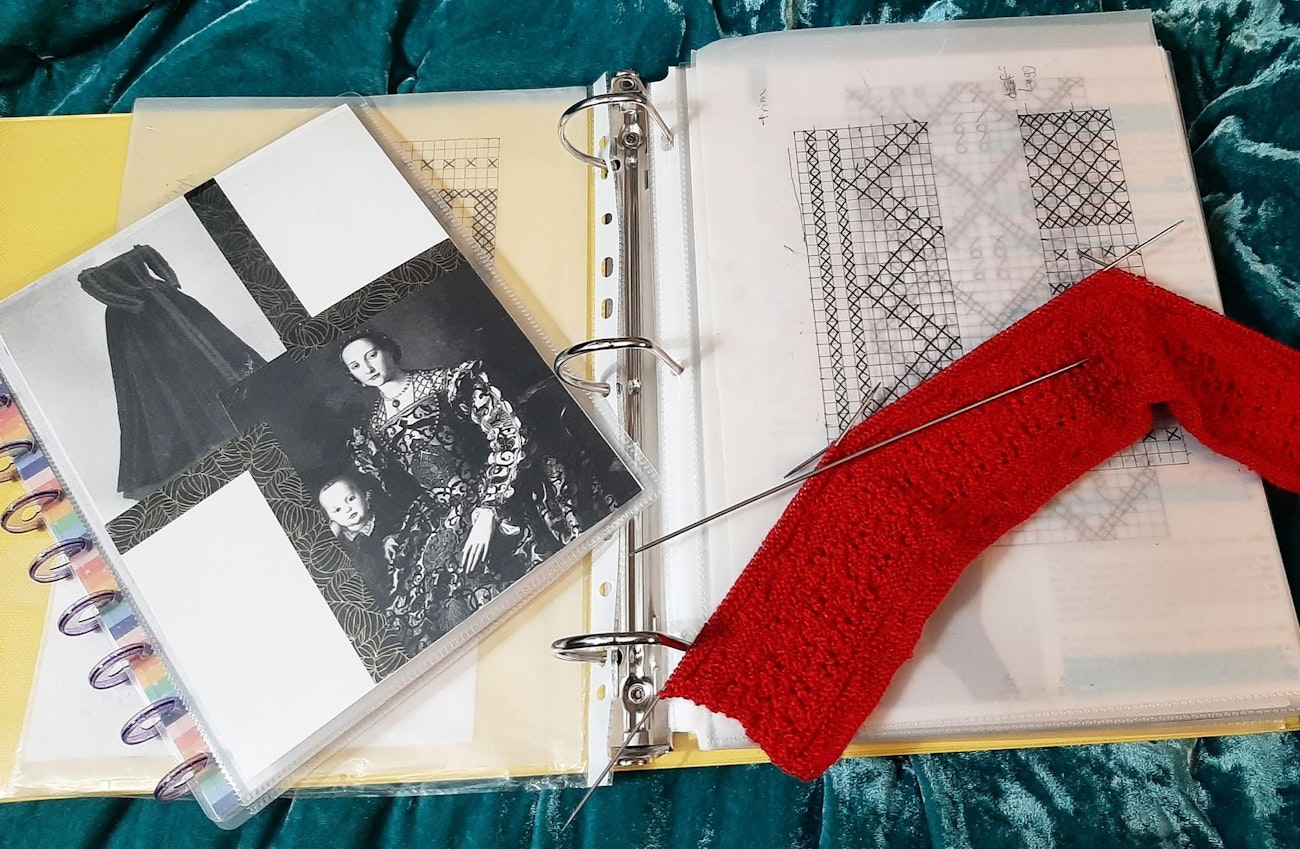In part one of this series, the author detailed the inspiration behind her quest to re-create the original burial stockings of Eleonora di Toledo. Read about it here.
In my quest to re-create and reimagine three pieces from the wardrobe of Eleonora di Toledo, I wanted to start by making the most faithful reproduction of her stockings possible using historical methods. Unfortunately, the originals are in Florence and I’m in Seattle, so going to see them in person was out of the question.
With help from fellow textile enthusiasts, I got copies of photos pre- and post-conservation from the Archivio de Medici website (now defunct) where, in the early 2010s, the Italian government shared information about the burial garments. From these I could estimate the leg length; foot length; calf, ankle, and foot width; and gauge because they were photographed on a 1 x 1 cm grid.

The author’s design notebook with her chart information and photo of her subject Eleonora di Toledo
Calculating the size
At the time, I didn’t know how tall Eleonora was, so I used the same calculations a medical examiner or anthropologist would use to determine the height of a person based on foot and tibia length, assuming the leg of the stocking to be roughly the same length as the longer bone of the lower leg. Later, I was able to confirm my estimate with information from the Medici Project, a multidisciplinary study of 49 Medici remains, which determined her height to be 5 feet 1.4 inches (158 cm).
All of this work was important because it helped determine the stockings would fit over the knee, and the cuff probably wouldn’t be worn folded over like some have suggested. Today, Eleonora would be a dainty woman with US size 7 feet. Her feet may have been smaller prior to her 11 pregnancies, as the added weight and inflammation are known to cause the bones to spread slightly. For this case, though, we’re relying on data from the skeletal remains and physical evidence left behind in her clothing at the time of her death.
The same photos that gave me the finished dimensions also provided gauge. The stockings were knit at about 5 stitches to the centimeter (about 9.5 stitches to the inch), and 6 rows/centimeter or 18.5 rows/inch.
And now . . . casting on
After consulting several yarn shops, websites, and my budget, I purchased Knit Picks Luminance Lace in the color “Passion,” a vibrant red suitable for the wardrobe of Eleonora, which was mostly black, red, white, and gold. This yarn is 100% silk, like the originals, budget friendly, and fine enough for my target gauge.

The author’s stockings in progress, knitted at 5 stitches to the centimeter.
I swatched several times using multiple combinations of yarn and needles, and finally settled on US 000/1.5mm with the yarn held double. Previously, I’d charted out the different patterns used in these stockings. I calculated my cast-on number using the cuff dimensions, gauge, and number of stitches in the pattern repeats/number of repeats on the original stockings, finally landing on 154 stitches.
So much work went into this knitted stocking project before ever casting on. From now on, I want my official job title to be “forensic knitter.”
Sheena Pennell is the author, editor, knitwear designer, and amateur historian behind KnotMagick Studios. She has studied art conservation with an emphasis on textiles in Florence, Italy. The Eleonora project is based on a portion of her thesis, which focused on the challenges facing conservators working with burial garments.

